Mood Brightener: ...more from Stay Homas. (Confination XVII)
You can easily follow the derivation of this result on the linked wiki page. Fundamentally this is the result of noticing that the magnetic force is ALWAYS perpendicular to the motion of the charged particle which is the same characteristic as the net force in the radial direction for circular motion. In a setting where the magnetic force is the only significant force in the problem then the net force in the radial direction must equal the magnetic force. A little algebra later and you have it:

which leads to....

....after a little algebra. The velocity is only the component of the velocity that is perpendicular to the B field. The component parallel to the B field experiences no magnetic force and is unaffected.
Applications:
There are a number of ways that this force has been useful in understanding the world. The first of these is in particle physics. In the old days particles were accelerated and then allowed to collide with a proton (nucleus of hydrogen) in a chamber with a magnetic field. In the image below the B field is either down into the page or up out of the page. The magnetic force on the charged particles resulting from such a collision then travel in circles through the liquid hydrogen leaving a small trail of bubbles behind. Uncharged particles leave no bubbles. On the left side of this image there is a vertex where one particle curls counter clockwise with a small radius. The other curls clockwise is a large radius. The vertex is a point where a neutral particle decayed (fell apart) into two equally charged particles (why must the charges be the same?).
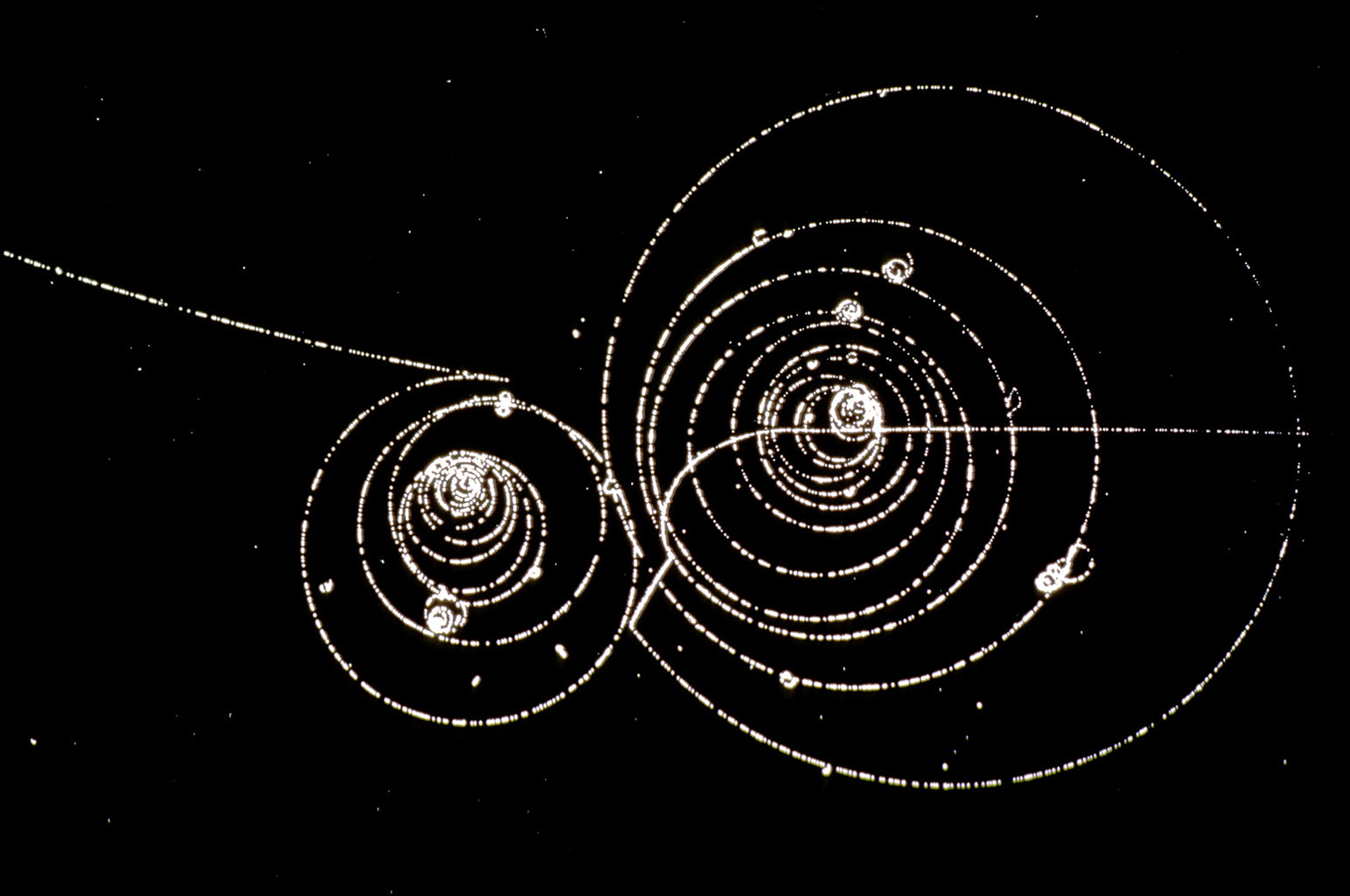
Then there is the question "Why do they spiral instead of move in circles?". Since, in the Larmor radius expression, the B field, the charge q, and the mass seem unlikely to be changing then it is reasonable to imagine that what is happening is that the particle is slowing down (losing energy) by crashing through the liquid hydrogen. Careful measurements of the spirals can determine the mass and velocity of the individual particles. These are the general ideas though there is lots more one could talk about.
More modern particle accelerators use different detectors but we're still looking at the shape of the track and branching to figure out what's going on. The histograms at the edge indicate how much energy was delivered to the end point of the track.
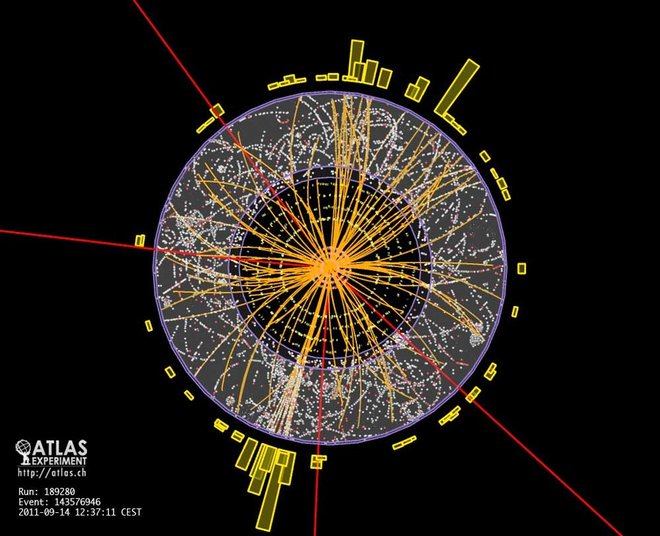
Aurora Borealis:
We also talked about this general idea that the earth's magnetic field protects us from high energy particles coming in from space and doing damage to our DNA. Let's visualize how that works...charged particles (mostly high energy protons) headed for the earth encounter the earth's magnetic field. Because of the tip of the earth this is usually at an angle. The component of the v of the particle parallel to the B field is unchanged but the perpendicular component generates a force which makes the particle circle around the B field line. The combination of the two velocities produces a helical path for the particle which travels to one end of the planet or the other. Can you figure out why is usually goes to the pole where it's winter season? Do a sketch and be sure you can make this argument clearly.
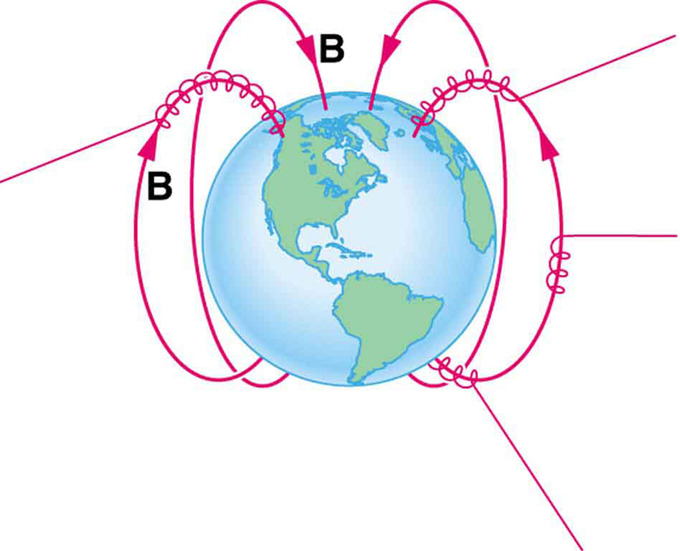
Magnetic Field Reversals:
When we tow a magnetometer (for measuring the intrinsic magnetic field of rocks) across the sea bottom of the coast of Washington and Oregon we see this pattern. Magma, which has a lot of iron rich minerals, rises to the surface along the Juan de Fuca ridge and spreads out towards the east and west (roughly). As the magma cools it captures the current magnetic environment. Where the dark bands are located the magnetic field in the sea floor is the same as it is now. The intervening regions have a magnetic field pointing in the opposite direction ('towards' the South end of the planet). This reversal of the earth's magnetic field has now been seen all around the globe and cataloged going back millions of years.
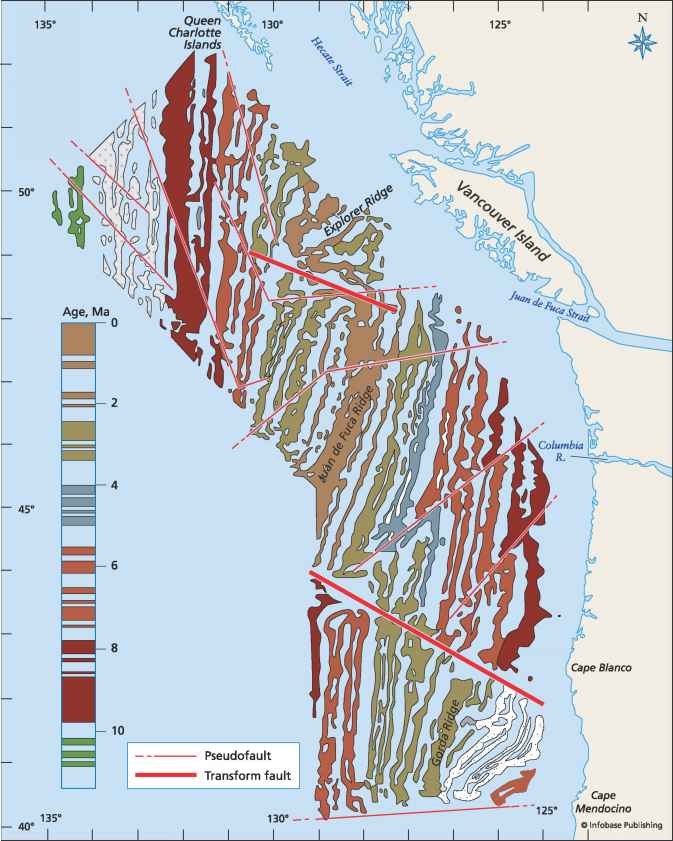
As we have (perhaps) noted previously the earth's magnetic field has collapsed and reversed multiple times over geologic time scales. Here is a map of the currently known reversals.

Given the discussion above about the Aurora Borealis what will happen to the charged particles coming from the sun and hitting the earth when there is no magnetic field? I can't find a good reference for exactly what the level of radiation the surface of the earth would experience if the field went away. The expectation is that the overall level of radiation exposure for human beings would go up in a modest way that would increase risks for pregnant women but wouldn't kill anyone directly.
Assignment Breadcrumb Reading: Bb Test
Gyroradius:
What is the minimum gyroradius for a proton moving at 500 km/s (a typical speed for protons from the sun when they reach the earth) in the earth's magnetic field of 50 μT?
Before Next Class:
Assignment HW: Bb Test
Trajectory vrs Charge:
The four particles below follow the trajectories shown in the presence of a B field pointing into the paper. What can you say about the charge of each particle? If the each particle has the same speed and charge rank the mass of the particles from greatest to least. Note if this is not possible for particular particle(s).
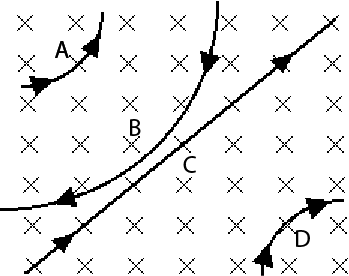
Assignment HW: Bb Test
Magnetic Turning Radius:
An electron with 2.4 keV of kinetic energy is headed horizontally towards a plate 1.2 m away. What is the magnitude and direction (many choices) of the minimum B field that will just prevent the electron from hitting the plate? You will need to determine the speed of the electron from the kinetic energy and convert the energy from eV to Joules.
Assignment HW: Bb Assignment
EM Velocity Selector (mass spec)
A proton is travelling simultaneously through an E field of 1.5 kV/m and a B field of 0.4 T. These fields are arranged in just such a way that the electric force cancels the magnetic force. Draw the E, B, and v vectors. What is the speed of the electron? Gravity does not play a role in this problem.
Looking Ahead:
Look ahead to the next Breadcrumb: Biot-Savart I
Assignment Breadcrumb Reading: Bb Assignment
Sketch Magnetic Field Around Straight Wire:
Sketch the magnetic field (using field lines) in the region surrounding a straight wire carrying a current. I'm interested in how you will choose to represent this B field. Be sure to clearly indicate the direction of the current and the direction of the B Field lines.
